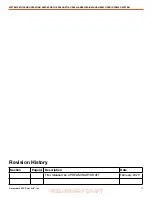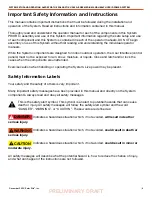
December 2020
|
Solar Stik
®
, Inc.
16
|
SYSTEM SETUP AND OPERATION GUIDE FOR THE SOLAR STIK USAF G-BOSS MEDIUM AND HEAVY HYBRID POWER SYSTEM
PRELIMINARY DRAFT
Load Prioritization
When the HPS is fully functioning, providing power to the load is always prioritized over other functions.
If renewable DC generators (i.e., PV arrays, wind, etc.) are producing power, it is immediately directed to
to the load once it flows into the HPS. The batteries will ONLY begin to charge once the DC generation
exceeds the demand from the load.
During periods of peak renewable DC generation, it may be exclusively used to support the load while
excess energy charges the batteries simultaneously. This function reduces the demand on the batteries,
prolongs battery-operation time, and promotes healthy cycling of the battery.
This same function also occurs when the HPS is connected to an AC source. If the HPS is connected to
an active generator or grid-utility, the load is always supported FIRST before any AC is used for charging
the HPS batteries. If the PRO-Verter is controlling a connected generator and the battery bank reaches
a low state of charge (SOC), the PRO-Verter can be programmed to auto-start the generator to keep
AC flowing to the load, only charging the connected batteries once the load is fully supported by the
generator.
Real-time Load Management
When connected to an active AC source, the PRO-Verter can automatically adjust (in real time) its
battery-charging rate to keep the total load value under the AC INPUT setting value.
If the load is dynamic, the PRO-Verter can make immediate adjustments and keep the total load on the
AC source from exceeding the value of the AC INPUT setting while still maintaining a 100% load at the
external AC source (generator or grid-utility).
It is incumbent on the operator to ensure the sum of all loads does not exceed the limit of the AC source
(generator or grid-utility) or the connections or circuit protections in the network. The AC INPUT (FAVS
03) setting should be set to the same value of the maximum AC output rating of the source. For example,
if the generator is rated for 3000 W continuous output, then the AC INPUT should be set for 25 A* (25 A
@ 120 VAC = 3000 W). See
section.
The overall health of the HPS can be determined by the amount of cycling that occurs in a 24-hour
period. If the HPS cycles more than twice daily or is experiencing irregular cycling, there are several
factors that may be causing it:
• Excessive load
• Inadequate battery capacity
• Heat-derated performance
• Disparity in battery SOC
Consult the troubleshooting sections for more details on causes of irregular or excessive cycling.
















































